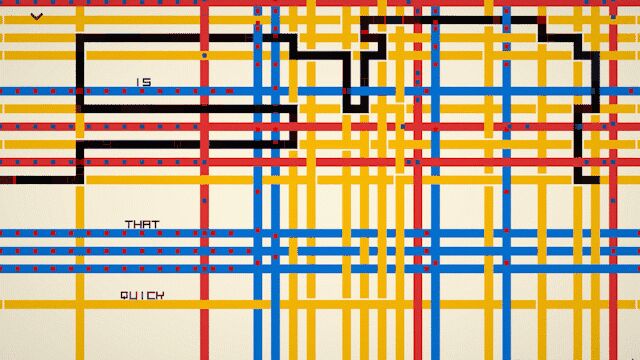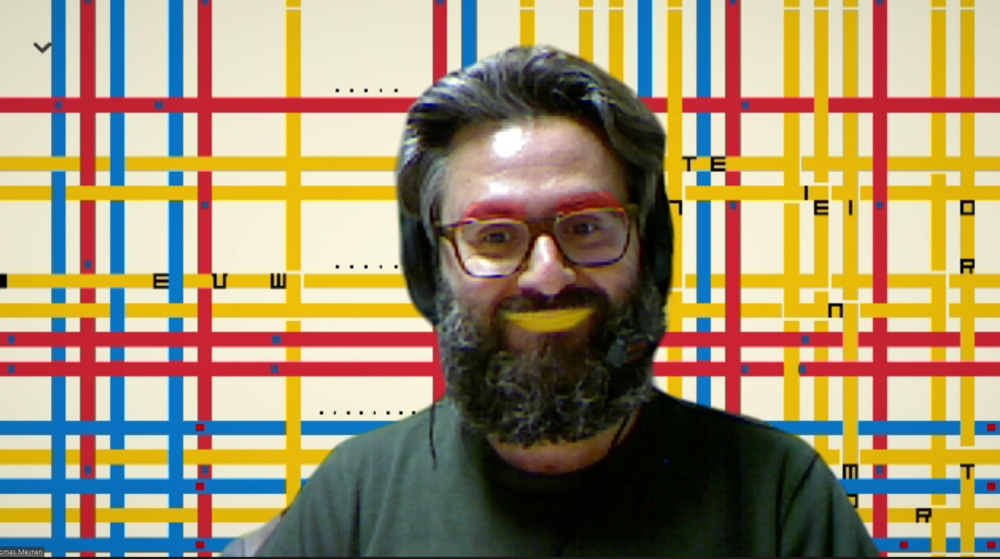 © Studio Waterzooi
© Studio Waterzooi
Please, Touch the Artwork, Thomas Waterzooi's debut game, has more to offer than its white-walled art gallery setting. It's a hybrid of psychogeography and "zen" art puzzles, as well as a direct descendant of classic video games like Snake and Pong. Please, Touch the Artwork is a challenging game that taps into the same hypnotic and compulsive vein as Snake, the smartphone standard that was installed on a billion Nokia phones in the late 1990s and early 2000s. Snake ( or Nibbles, its MS-DOS equivalent) let you grow your snake by eating dots on a small monochrome screen, and once you had eaten your own elongated tail, the game was over.
Snake became a shared experience that defined a formative age of cellphone culture and the idea of what casual gaming could be, since phone games were so rare back then. Please, Touch the Artwork isn't a Nokia game (although it's available on smartphones, Steam, and itch), but it goes back in time to explore the same themes that made games like Snake and Pong so popular. .
Waterzooi creates a minimalist wall you can project your thoughts onto using lines, blocks, primary colors and negative space. It's not just about getting from point A to point B, but about imbuing your discoveries with meaning. In the Boogie Woogie Gallery, you'll meet two "characters" (who are actually just dots on a screen) and learn the rules that govern their connection, while in the New York City Gallery, your movements will simulate commotion ( and, sometimes, loneliness) of city life. Waterzooi creates an ode to art history that appeals to our intrinsic affinity for sharp lines and bold colors using Dutch artist Piet Mondrian's abstract painting (you're sure to know his work even if you don't). not his name). Cats are attracted to the snapping hand cursor.
The psychogeographic aspect is strongest in the New York gallery, which combines Snake-like puzzles with a rambling poem about a deteriorating relationship. It's the game's most traditional linear narrative, as well as the most philosophically cohesive. While the influence obviously comes from Mondrian's series of New York City paintings, it also reminds me of Massimo Vignelli and Bob Noorda, who developed the iconic New York City subway map in 1967.
The minimalist environment immediately took me back to 2006, when I moved to New York and had to navigate the MTA, the maze of one-way streets and the personal turmoil that comes with the early twenties. It's a visual drama that works even if you've never been to New York, because the subway map has become a cultural image of what we imagine New York City is through movies, TV, and novels.
The journey through this particular depiction of New York tells the familiar story of a long-distance relationship in which one partner moves to the big city: the feeling of social overstrain to distract from latent issues; the feeling of comfort with each visit; and loneliness when the other returns "home". As the chapter progresses, the colors and subway lines change and move - a claustrophobic fisheye lens effect, a gloomy film of rain, dull "winter" weather, and rhythmic cascades of commuters (stylized as dots) crossing map bring the grid to life. Bringing up a large, impersonal map or having the camera fixed on your crosshairs, without being able to pan around to see the big picture, are simple but effective framing methods that match the highs and lows of the poem. .
It's a brilliant use of abstract imagery to tell a story that's both personal and universal, if a bit monotonous towards the end, as some relationships are. As you travel along the subway lines to the appropriate nodes, the sense of visual and conceptual disharmony on the "maps" is balanced, revealing more of the poem and ultimately propelling the story to its bereaved end. .
The Style is where I really felt the full weight of puzzle difficulty, as well as a great potential sense of community à la Wordle. The other two galleries aren't as well built as New York (Boogie Woogie wasn't the most interesting of the three), but that's where I really felt all the difficulty of the puzzles, as well as great potential of community at the Wordle. Waterzooi deconstructs the works of Mondrian's neo-plasticism in this gallery, using the painter's visual language - simple geometry and primary colors - to convey a theatrical story of creation (and ultimately, a farewell).
All you have to do mechanically is copy a painting onto a blank canvas. It seems simple until it isn't. Mondrian's neo-plastic movement advocated the use of a common aesthetic language so that everyone could communicate effectively (no green, no curves, no masters). Accordingly, The Style, armed with the same visual vocabulary as Wordle, sings the same siren song - I easily imagine myself tackling one puzzle a day and comparing the results with pals on a bewilderingly colorful grid. Separately, but together, we play the same game. We have moved from a physical and geographical sense of location to a metaphorical common space. And as the game progresses, the challenges get harder and harder. There are diagonals, directional lines, and other masochistic elements to create a fun, masochistic experience.
Please touch the artwork, of course, offers no scoring or measurement as a self-described "zen" game (but The Style shows you the perfect/optimal number of moves). There is no time limit for this game. As if you were walking through the many wings of a museum, you can move from one gallery to another and look at them in any order you want. But when you leave, you'll feel unmistakably like you've touched a piece of art history in a whole new way, and part of a zeitgeisty wave of small, shared experiences expressed through a simple visual language (you see, there is still that Wordle vibe). I hesitate to call it "art Wordle" and, to be honest, that brief definition only applies to The Style, but it might be the easiest way to convince you to give it a try.


 Jean Dubreil
Jean Dubreil